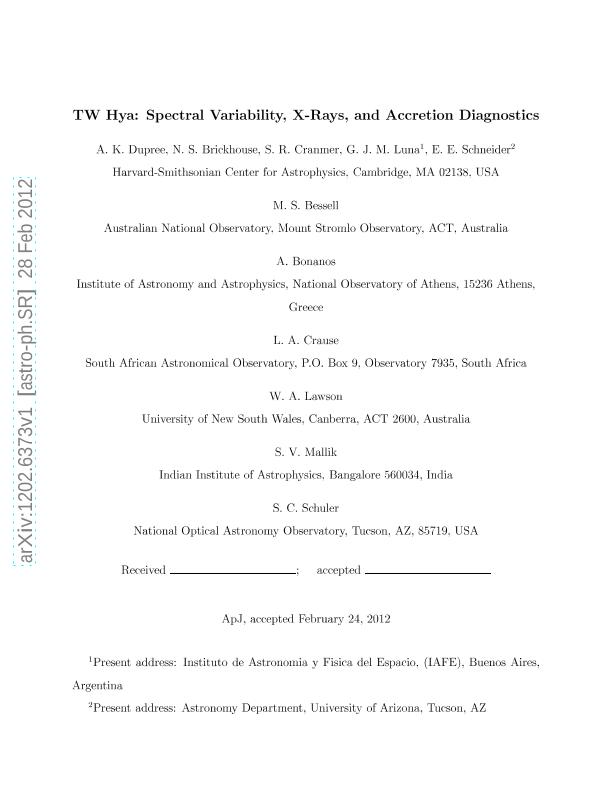Mostrar el registro sencillo del ítem
dc.contributor.author
Dupree, A. K.
dc.contributor.author
Brickhouse, N. S.
dc.contributor.author
Cranmer, S. R.
dc.contributor.author
Luna, Gerardo Juan Manuel

dc.contributor.author
Schneider, E. E.
dc.contributor.author
Bessell, M. S.
dc.contributor.author
Bonanos, A.
dc.contributor.author
Crause, L. A.
dc.contributor.author
Lawson, W. A.
dc.contributor.author
Mallik, S. V.
dc.contributor.author
Schuler, S. C.
dc.date.available
2017-06-22T17:46:44Z
dc.date.issued
2012-04-17
dc.identifier.citation
Dupree, A. K.; Brickhouse, N. S.; Cranmer, S. R.; Luna, Gerardo Juan Manuel; Schneider, E. E.; et al.; TW Hya: Spectral Variability, X-Rays, and Accretion Diagnostics; Iop Publishing; Astrophysical Journal; 750; 1; 17-4-2012; 73-93
dc.identifier.issn
0004-637X
dc.identifier.uri
http://hdl.handle.net/11336/18654
dc.description.abstract
The nearest accreting T Tauri star, TW Hya was intensively and continuously observed over ~17 days with spectroscopic and photometric measurements from four continents simultaneous with a long segmented exposure using the Chandra satellite. Contemporaneous optical photometry from WASP-S indicates a 4.74 day period was present during this time. The absence of a similar periodicity in the Hα flux and the total X-ray flux which are dominated by accretion processes and the stellar corona, respectively, points to a different source of photometric variations. The Hα emission line appears intrinsically broad and symmetric, and both the profile and its variability suggest an origin in the post-shock cooling region. An accretion event, signaled by soft X-rays, is traced spectroscopically for the first time through the optical emission line profiles. After the accretion event, downflowing turbulent material observed in the Hα and Hβ lines is followed by He I (λ5876) broadening near the photosphere. Optical veiling resulting from the heated photosphere increases with a delay of ~2 hr after the X-ray accretion event. The response of the stellar coronal emission to an increase in the veiling follows ~2.4 hr later, giving direct evidence that the stellar corona is heated in part by accretion. Subsequently, the stellar wind becomes re-established. We suggest a model that incorporates the dynamics of this sequential series of events: an accretion shock, a cooling downflow in a supersonically turbulent region, followed by photospheric and later, coronal heating. This model naturally explains the presence of broad optical and ultraviolet lines, and affects the mass accretion rates determined from emission line profiles.
dc.format
application/pdf
dc.language.iso
eng
dc.publisher
Iop Publishing

dc.rights
info:eu-repo/semantics/openAccess
dc.rights.uri
https://creativecommons.org/licenses/by-nc-sa/2.5/ar/
dc.subject
Accretion, Accretion Disks
dc.subject
Stars: Individual (Tw Hydrae)
dc.subject
Stars: Pre-Main Sequence
dc.subject
Stars: Variables: T Tauri, Herbig Ae/Be
dc.subject.classification
Astronomía

dc.subject.classification
Ciencias Físicas

dc.subject.classification
CIENCIAS NATURALES Y EXACTAS

dc.title
TW Hya: Spectral Variability, X-Rays, and Accretion Diagnostics
dc.type
info:eu-repo/semantics/article
dc.type
info:ar-repo/semantics/artículo
dc.type
info:eu-repo/semantics/publishedVersion
dc.date.updated
2017-06-21T18:56:08Z
dc.journal.volume
750
dc.journal.number
1
dc.journal.pagination
73-93
dc.journal.pais
Reino Unido

dc.journal.ciudad
Londres
dc.description.fil
Fil: Dupree, A. K.. Harvard-Smithsonian Center for Astrophysics; Estados Unidos
dc.description.fil
Fil: Brickhouse, N. S.. Harvard-Smithsonian Center for Astrophysics; Estados Unidos
dc.description.fil
Fil: Cranmer, S. R.. Harvard-Smithsonian Center for Astrophysics; Estados Unidos
dc.description.fil
Fil: Luna, Gerardo Juan Manuel. Consejo Nacional de Investigaciónes Científicas y Técnicas. Oficina de Coordinación Administrativa Ciudad Universitaria. Instituto de Astronomía y Física del Espacio. - Universidad de Buenos Aires. Facultad de Ciencias Exactas y Naturales. Instituto de Astronomía y Física del Espacio; Argentina
dc.description.fil
Fil: Schneider, E. E.. Harvard-Smithsonian Center for Astrophysics; Estados Unidos
dc.description.fil
Fil: Bessell, M. S.. Australian National Observatory; Australia
dc.description.fil
Fil: Bonanos, A.. National Observatory of Athens; Grecia
dc.description.fil
Fil: Crause, L. A.. South African Astronomical Observatory; Sudáfrica
dc.description.fil
Fil: Lawson, W. A.. University Of New South Wales; Australia
dc.description.fil
Fil: Mallik, S. V.. Indian Institute of Astrophysics; India
dc.description.fil
Fil: Schuler, S. C.. National Optical Astronomy Observatory; Estados Unidos
dc.journal.title
Astrophysical Journal

dc.relation.alternativeid
info:eu-repo/semantics/altIdentifier/doi/http://dx.doi.org/10.1088/0004-637X/750/1/73
dc.relation.alternativeid
info:eu-repo/semantics/altIdentifier/url/http://iopscience.iop.org/article/10.1088/0004-637X/750/1/73/meta
dc.relation.alternativeid
info:eu-repo/semantics/altIdentifier/url/https://arxiv.org/abs/1202.6373
Archivos asociados
